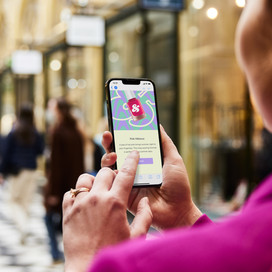Table of contents
COVID-19 is changing the way stores do business, prompting an accelerated shift to online sales and services like click and collect, delivery, and virtual experiences.
Customers are embracing these new shopping options for their safety and convenience, giving retailers more ways to interact. But to offer a successful omnichannel retail experience, it’s not enough to just show up on these channels. Each channel needs to work together to create a unified, consistent experience for your customers. This is where omnichannel strategy comes in.
Whether you focus on eCommerce sales, in-store experiences, or a mix of both, you want your customers to recognise your brand inside every interaction. The service customers receive in-store should translate across your online store, social media channels, and delivery platforms.
Read on to see how business owners like you can train their teams to engage with shoppers across five important channels.
Match your service with customers’ needs
Consider holding weekly video calls with your team to train them on how to engage with customers during such an unusual time. Go over safety protocols and the various ways your staff can best help customers. Some customers want a contactless environment where staff members touch the products for them, while others prefer to be left alone to browse. Train your employees on how to match their service with each customer’s comfort level and needs.
It’s important to look beyond your normal business operations, too.
To evolve the in-store experience, check in with other business owners selling in similar markets across the country or in your region. You might even attend webinars hosted by retail experts to see how they’re innovating. Encourage your staff to provide their input on these new ideas, asking them to draw from their personal shopping experiences during COVID-19.
Help employees brush up on product knowledge
To provide a positive in-store experience, your staff needs to know about the products they sell. That way, your employees can give customers the information they need to make informed purchasing decisions, no matter where they are.
It’s also important to educate your team on what you’re selling and how those products show up on each channel. Consider asking your team to visit specific sections of your website, and then talk through any questions they would imagine first-time or repeat customers having about individual products and the online shopping experience in general.
Make online operations a part of your training
The pandemic has impacted most industries in some way. Businesses have had to learn new omnichannel retail strategies to sell everywhere, not just in their brick-and-mortar stores.
If customers aren’t ready for in-store shopping, it’s important to direct them to the other places they can find you, like your online store or social media profiles. Consider offering kerbside pickup or free shipping on local orders to make it easy and comfortable for them to shop with you.
When COVID-19 forced temporary lockdowns, reducing in-person business, Market Lane Coffee, a coffee roastery, café, and retail shop with six locations throughout Melbourne, wanted to ensure that their online operations were solid so that customers would continue to have a seamless online shopping experience if they weren’t comfortable entering the stores.
Fleur Studd, co-owner of Market Lane said, “One lesson has been to stay focused on doing what we do well, rather than trying to pivot too far away from what we are already good at. We have invested a lot of time in making sure our website, online store and Coffee Club subscription service are as strong as they can be.”
It may also be beneficial to train every employee to handle each aspect of the business. This way, as online sales increase, each employee will know how to accommodate increased production work or fulfil online orders. Employees who are cross-trained may provide the same level of service customers expect across all channels.
Turn social outreach into sales opportunities
You can turn your social media profiles into eCommerce channels. Phones are becoming essential tools for customers to shop, with social media increasing in importance in terms of omnichannel marketing. Consider embedding your Instagram feed on the homepage of your online store to easily help customers engage with your business across platforms.
Get your staff involved by making sure they know what’s being featured on your social media accounts so they can quickly and accurately answer questions. And because you may experience a higher volume of questions online because of social distancing, ask a member of your team to be responsible for checking those pages for customer questions and feedback.
Train your employees to respond promptly and professionally by putting together a list of sample responses to common customer questions, and provide feedback on their responses. Other customers watch how you interact on these public forums, so it’s important to provide the best possible service.
Small-business owner Samantha Abbott, a glass jewellery artist based in East Gippsland, is also using social media to communicate with customers, as the markets she typically sells at are either temporarily shut down or have fewer customers due to COVID-19. She creates Facebook and Instagram content to support her jewellery and give customers a better feel for the pieces she has in stock. She’s using social media to elicit feedback from her customers about what designs they may want her to make next.
Meeting customers’ current needs is important. Try making your social media posts relevant for what customers are currently experiencing. For example, if your company is in the toy industry, try featuring educational toys that enhance distance learning, as many children are participating in virtual classrooms.
Build a virtual community
When nonessential businesses were forced to close at the beginning of the pandemic, some business owners took their services online using video conferencing. Appointment-based shopping sessions, workshops, and consultations continue to provide a way to stay connected to customers who aren’t comfortable visiting a physical location. If this is relevant to your business, incorporate appointment-booking software to easily manage sessions.
Grace Loves Lace is an Australia-based bridal shop with showrooms in the United States and the United Kingdom. Due to the reduced in-store visits during lockdowns, the company began offering online virtual appointments, where customers can meet one-on-one with a stylist to shop for wedding gowns, veils, shoes, and accessories.
When shifting to virtual offerings, make sure your technology can support it. You’ll want to maintain that feeling of connection, so be sure that staff members who lead sessions are trained on the technology and have the right setup. Consider upgrading your associates’ phones or tablets to the most updated models with high-quality cameras. Creating a good mobile setup allows associates to walk easily through the store with customers and show them a variety of available products.
Like Grace Loves Lace, training your team to host online appointments is an effective way to meet customer demand and create a great omnichannel user experience.
Don’t forget about delivery
Getting your products into customers’ hands isn’t just about logistics; it should also match your brand. So, if your in-store shopping experience is based on speed and convenience, your delivery logistics should mirror that.
Invest in different forms of order fulfilment, like local delivery, shipping, and same-day kerbside pickup. Giving customers options helps them choose the most convenient fulfilment method.
Offering multiple ways for customers to buy from you is particularly important this Christmas season, considering the growing concern over shipping delays and supply chain issues. According to an Oracle report, 58 percent of consumers in four regions—including Australia—plan to spend the same amount or more during the 2020 holiday season compared to the 2019 holiday season.
Have your staff encourage customers to shop early this year, by promoting holiday gift wrapping, offering free local delivery, and posting shopping reminders on social media accounts. And remember that ensuring secure payments is key to earning (and keeping) customer trust. With the potential for more consumer spending this season, train your team to use Square’s virtual terminal to easily and securely accept payments on your computer.
Another important aspect of delivery is your branding. Even if customers don’t set foot in your store, they should feel a connection to your business when they open their packages at home. Include your company branding in every method and touchpoint, and consider including small trinkets or gifts with online orders to help make the experience special.
Urban Rituelle, a New South Wales boutique selling bath, body and fragrance products, includes a free organic bar soap with every order. This type of promotion is not only an effective omnichannel marketing strategy for increasing brand awareness, but it also may help increase sales.
The omnichannel experience starts with your team
With customers reaching out across more channels than ever before, creating an omnichannel strategy for your business is essential. And your team is at the heart of that plan.
Employees who are well-trained and well-informed can help you deliver a more connected shopping experience everywhere your business shows up.
![]()











